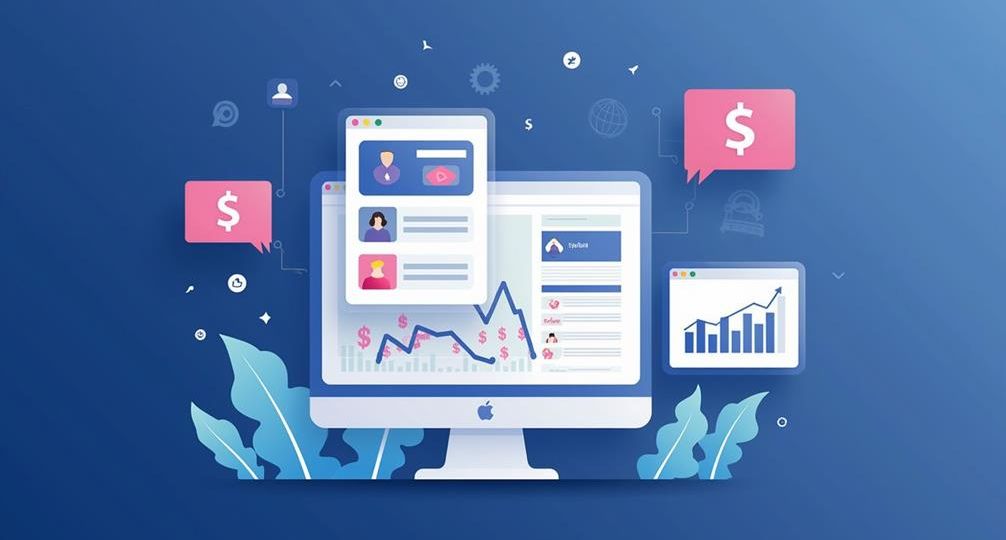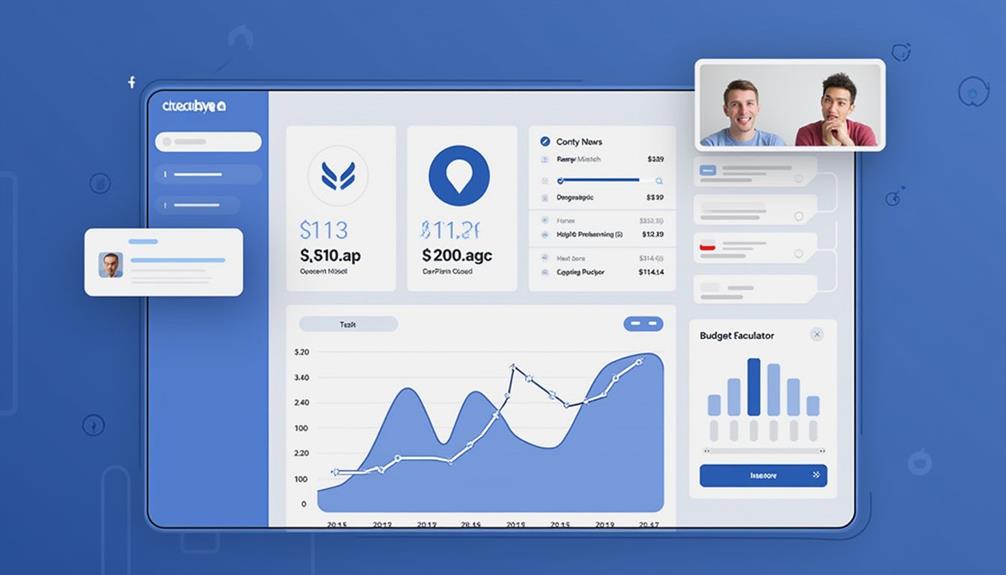
How much does it cost to reach 10000 people on Facebook?
When you’re planning to reach 10,000 people on Facebook, the cost isn’t straightforward—it depends on several key factors. Seasonality, competition in your niche, and how precisely you target your audience can all influence your expenditure. Typically, you might spend between $50 to $150, given that the average CPM ranges from $5 to $15. But how do you guarantee your budget is used effectively and your ad stands out in a crowded space? Let’s explore the strategies that can optimize your spend and maximize engagement.
Key Takeaways
- CPM determines the cost; an average CPM of $5 means reaching 10,000 people costs approximately $50.
- Ad quality affects CPM; higher quality ads can reduce CPM by up to 50%.
- Ad seasonality trends impact costs; peak seasons may increase CPM due to higher competition.
- Demographic targeting and interest alignment can influence overall costs.
- Regular review of CPM and competitor analysis helps optimize ad spend efficiency.
Factors Affecting Ad Costs

When you’re trying to reach 10,000 people on Facebook, several factors can considerably impact your ad costs.
First, you’ll want to understand ad seasonality trends. During peak seasons like holidays, more businesses compete for ad space, driving up costs. Conversely, off-peak times can offer more affordable rates. Analyzing these trends helps you strategically time your campaigns for maximum impact and cost-efficiency.
Next, competitor analysis is vital. By studying what your competitors are doing—such as their ad formats, targeting strategies, and engagement metrics—you gain insights that can refine your approach. If your competitors ramp up their spending, your costs may rise due to increased bidding competition.
Additionally, consider your ad creative and relevance score. High-quality, engaging ads often receive better placement and lower costs. Facebook’s algorithm favors ads that resonate with your target audience, so focus on creating compelling content.
Lastly, your targeting parameters—such as demographics, interests, and behaviors—play a significant role. The more specific your targeting, the higher the costs can be, but the trade-off is often better engagement.
Understanding CPM and CPC
Understanding CPM (Cost Per Thousand Impressions) and CPC (Cost Per Click) is essential for optimizing your Facebook ad spend. CPM measures the cost of 1,000 ad impressions, while CPC focuses on the cost each time someone clicks on your ad. Mastering these metrics lets you allocate your budget more effectively and maximize your reach.
To break it down:
- CPM Calculation: This metric is calculated by taking the total ad spend, dividing it by the number of impressions, and then multiplying by 1,000. For example, if you spend $50 and get 10,000 impressions, your CPM is $5.
- CPC Comparison: CPC is calculated by dividing the total ad spend by the number of clicks. If you spend $50 and get 100 clicks, your CPC is $0.50. Comparing CPC across campaigns helps identify which ads are more cost-effective.
- Strategic Use: Use CPM to measure brand awareness campaigns and CPC for direct response campaigns. Understanding when to use each can greatly impact your ROI.
- Data-Driven Decisions: Regularly review your CPM and CPC to identify trends and make data-driven adjustments to your strategy.
Targeting Your Audience

To optimize your ad spend on Facebook, use demographic and interest filters to zero in on your ideal audience.
Leverage behavioral targeting techniques to reach users with specific online behaviors that align with your campaign goals.
This strategic approach guarantees your budget impacts the right 10,000 people, maximizing your ROI.
Demographic and Interest Filters
Effective targeting is essential for maximizing your ad spend on Facebook, and using demographic and interest filters can greatly enhance your campaign’s performance.
By leveraging demographic segmentation, you can zero in on specific audience characteristics like age, gender, location, and education. This precision guarantees your ads reach the right people without wasting resources.
Interest alignment is another powerful tool. Facebook allows you to target users based on their hobbies, favorite activities, and even brands they follow. When your ads align with the interests of your audience, they’ll be more engaging and effective.
Here are some strategic tips:
- Utilize Detailed Demographics: Segment your audience by age, gender, education, and job title to guarantee your message resonates.
- Leverage Interest Categories: Target users based on their interests, such as sports, technology, or health, to increase engagement.
- Combine Filters: Use both demographic and interest filters to create a highly refined audience.
- Analyze Performance: Regularly review your ad performance to adjust your targeting and improve results.
Behavioral Targeting Techniques
Behavioral targeting techniques can supercharge your Facebook ad campaigns by focusing on users’ actions and behaviors rather than just their demographics or interests. By leveraging behavioral insights, you can create precise audience segmentation that boosts engagement metrics and drives better results.
Start with custom audiences based on user behavior, such as website visits or specific actions taken within your app. Use conversion tracking to understand which behaviors correlate with high purchase intent. This data allows you to develop effective retargeting strategies, guaranteeing that your ads reach users who are more likely to convert.
Lookalike audiences can further amplify your reach. By analyzing engagement metrics from your custom audiences, Facebook can identify new users with similar behaviors, extending your campaign’s effectiveness.
Monitor ad frequency to avoid overexposure and guarantee your message stays fresh and relevant.
Incorporating these strategies doesn’t just optimize your ad spend; it fine-tunes your approach based on real-time data. Whether you’re aiming to drive sales, increase sign-ups, or boost brand awareness, understanding and using behavioral targeting techniques can make your campaigns more strategic and impactful.
Adopting these innovative practices will position you ahead of competitors, maximizing your return on investment.
Ad Placement Options
When evaluating the cost to reach 10,000 people on Facebook, understanding the various ad placement options is essential.
Different ad placement strategies can greatly impact your campaign’s efficiency and cost-effectiveness. Facebook offers multiple placements, each with unique ad format effectiveness. Optimizing these placements can help maximize your reach within budget constraints.
Here are some key ad placement options to evaluate:
- Facebook News Feed: Highly visible and engaging, the News Feed is the prime real estate for capturing user attention. It’s ideal for image and video ads.
- Instagram Feed: Leveraging Instagram’s visual-centric platform can enhance your ad’s appeal, particularly useful for brands targeting younger demographics.
- Audience Network: Extends your ad reach beyond Facebook to third-party apps and websites, providing broader exposure at potentially lower costs.
- Stories: Full-screen, immersive ads on Facebook and Instagram Stories can drive higher engagement with their interactive features.
Ad Quality and Relevance

Boost your campaign’s effectiveness by optimizing your ad content and precisely targeting your audience.
High-quality, relevant ads can lower your cost-per-thousand-impressions (CPM) by up to 50%, according to recent studies.
Guarantee your message resonates with the right people to maximize your budget and reach.
Ad Content Optimization
Optimizing your ad content is essential for achieving high ad quality and relevance scores on Facebook, which in turn directly impacts your cost to reach 10,000 people.
High-quality content and relevance signal to Facebook’s algorithm that your ad is valuable, leading to lower costs.
To excel, focus on various content formats and engagement strategies. Different formats like videos, carousel ads, and interactive posts can capture your audience’s attention more effectively.
Data shows that video content, for example, generates 135% more organic reach compared to photos. Your engagement strategies should encourage likes, comments, and shares to amplify your ad’s impact.
Here are key tactics to optimize your ad content:
- Use Eye-Catching Visuals: High-resolution images and compelling videos naturally attract more engagement.
- Craft Compelling Headlines: An attention-grabbing headline can make the difference between a scroll and a click.
- Leverage User-Generated Content: Showcasing real customer experiences builds authenticity and trust.
- A/B Testing: Experiment with different ad copies and formats to find what resonates best with your audience.
Target Audience Precision
Achieving precise targeting can greatly enhance your ad quality and relevance, which directly lowers your cost to reach 10,000 people on Facebook. To start, leveraging audience segmentation allows you to pinpoint specific demographics, behaviors, and interests. This precision guarantees your ads resonate with individuals most likely to engage, thereby improving ad performance metrics like click-through rates (CTR) and conversion rates.
Market research plays an essential role in refining your audience segmentation. By analyzing data on customer preferences, pain points, and purchasing behaviors, you can create highly targeted ad campaigns. This not only maximizes your ad spend efficiency but also boosts the overall relevance score of your ads.
Facebook’s algorithm favors high-relevance ads, rewarding them with lower costs and broader reach.
Utilize Facebook’s Custom Audiences and Lookalike Audiences features to fine-tune your targeting. Custom Audiences let you retarget existing customers, while Lookalike Audiences help you reach new users similar to your best customers. Both strategies are data-driven and align with your goal of innovative marketing.
Budgeting and Bidding Strategies
Effective budgeting and bidding strategies are essential to maximizing your reach on Facebook while minimizing costs. Setting clear budget limits guarantees you don’t overspend while still achieving your campaign objectives.
Utilize Facebook’s bidding options to enhance how much you’re willing to pay for each impression or action. Audience segmentation allows you to target specific groups, increasing the efficiency of your ad spend. Ad scheduling guarantees your ads run when your target audience is most active, maximizing engagement.
To refine your strategy, consider the following:
- Budget Limits: Set daily or lifetime limits to control spending and allocate funds effectively.
- Bidding Options: Choose between cost-per-click (CPC), cost-per-impression (CPM), or cost-per-action (CPA) based on your goals.
- Audience Segmentation: Divide your audience into segments to tailor ads and increase relevance.
- Ad Scheduling: Schedule ads to run during peak times to boost visibility and interaction.
Analyzing performance metrics regularly helps you adjust budget and bidding strategies, guaranteeing ideal cost analysis.
Analyzing Campaign Performance

Once you’ve established your budgeting and bidding strategies, the next step is to analyze your campaign’s performance to guarantee you’re getting the best return on investment. Diving into campaign metrics and setting performance benchmarks is essential to optimizing your strategy.
Start by examining key metrics such as click-through rates (CTR), conversion rates, and cost per acquisition (CPA). These data points will give you a clear picture of how effectively your campaign is engaging your target audience and driving desired actions.
| Metric | Benchmark | Importance |
|---|---|---|
| Click-Through Rate (CTR) | 1-2% | Measures ad engagement |
| Conversion Rate | 2-5% | Indicates success in driving actions |
| Cost Per Acquisition (CPA) | Varies by industry | Assesses cost-efficiency |
Regularly compare your campaign’s metrics against these benchmarks to identify areas for improvement. For example, if your CTR is below 1%, consider revising your ad copy or visual elements to better capture attention.
Utilize Facebook’s built-in analytics tools to track performance in real-time. This allows for agile adjustments to your campaigns, ensuring you stay competitive and innovative.

